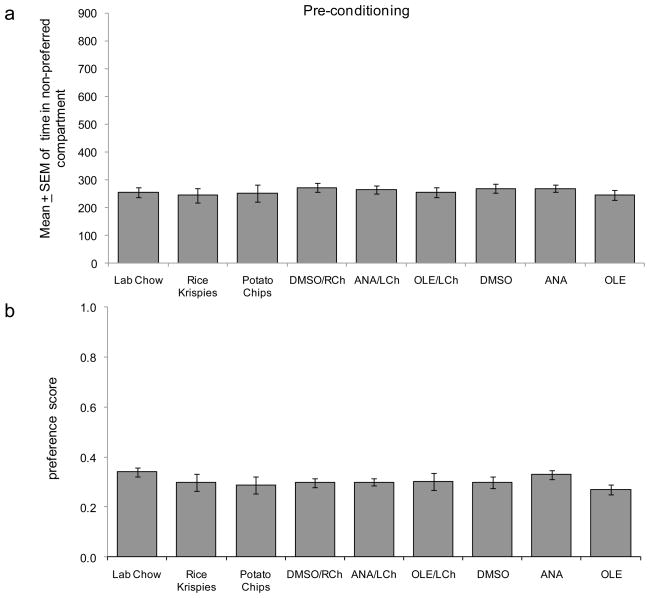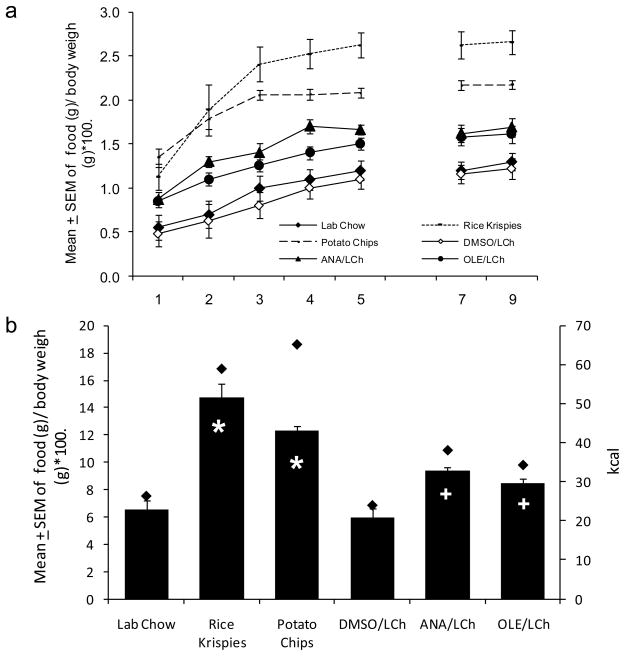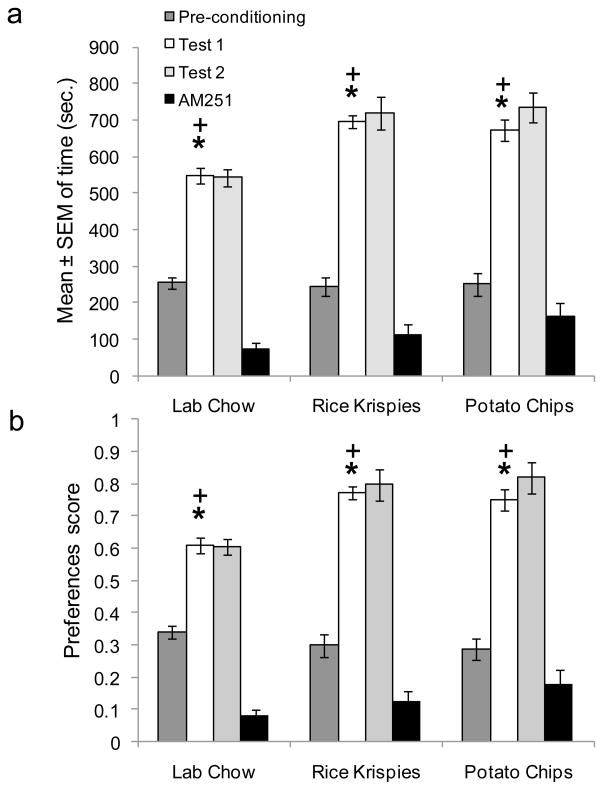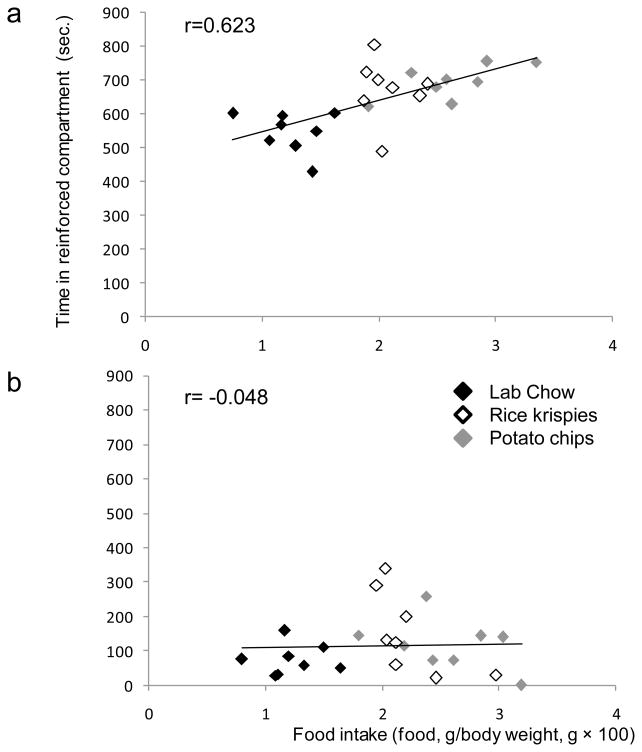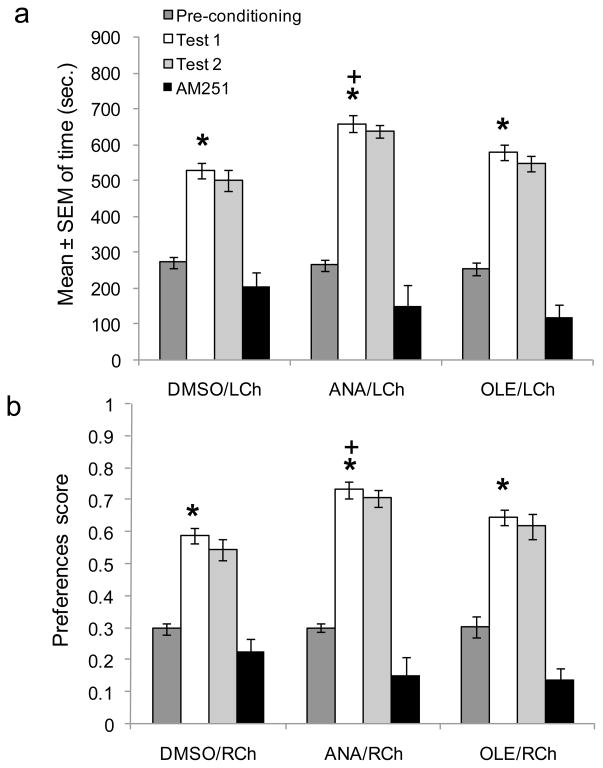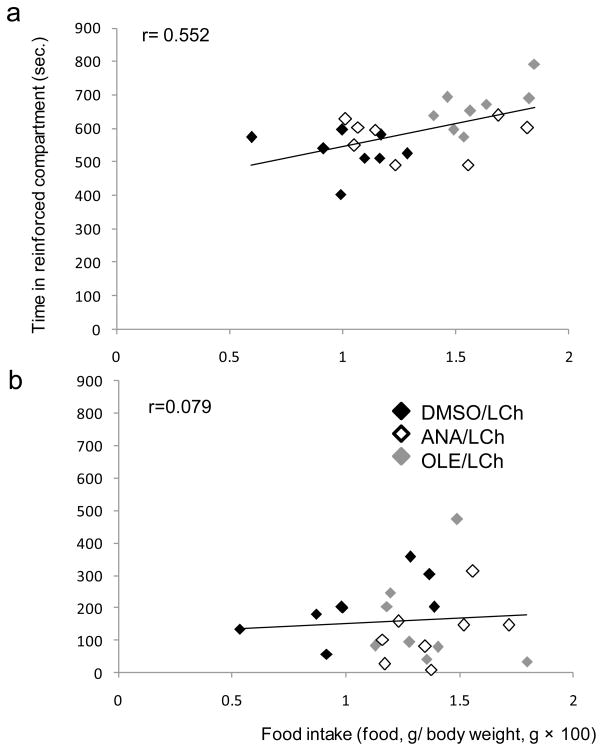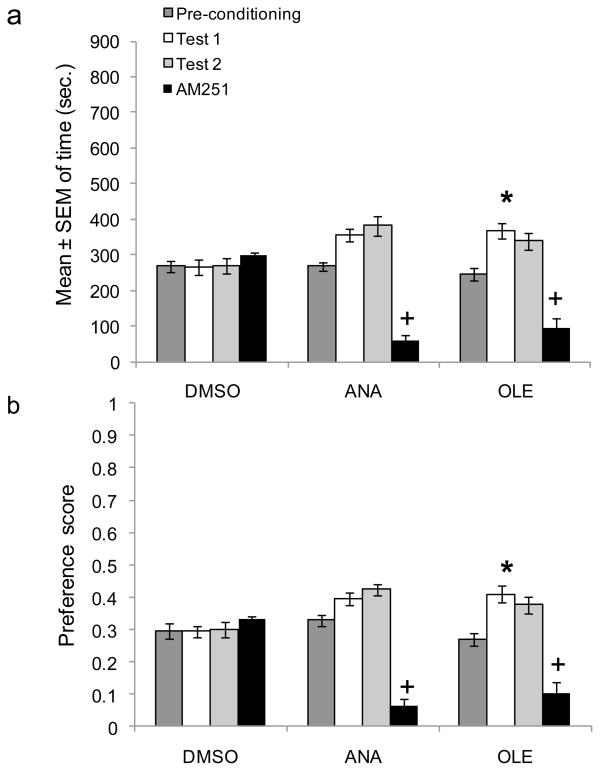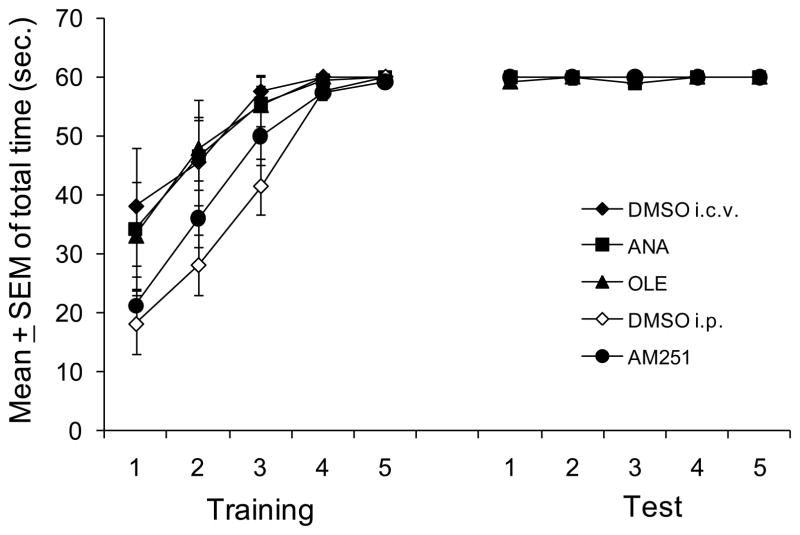Abstract
Endocannabinoids (eCBs) are mediators of the homeostatic and hedonic systems that modulate food ingestion. Hence, eCBs, by regulating the hedonic system, may be modulating the valence of the emotion associated to food ingestion (positive: pleasant, or negative: unpleasant). Our first goal was to demonstrate that palatable food induces conditioned place preference (CPP), hence a positive valence emotion. Additionally, we analyzed if this CPP is blocked by AM251, inducing a negative valence emotion, meaning avoiding the otherwise pursued compartment. The second goal was to demonstrate that CPP induced by regular food would be strengthened by the simultaneous administration of anandamide or oleamide and if such CPP is blocked by AM251. Finally, we tested the capacity of eCBs (without food) to induce CPP. Our results indicate that rats readily developed CPP to palatable food, which was blocked by AM251. The CPP induced by regular food was strengthened by eCBs and blocked by AM251. Finally, oleamide, unlike anandamide, induced CPP. These results showed that eCBs mediate the positive valence (CPP) of the emotion associated to food ingestion. It was also observed that the blockade of the CB1 receptor causes a loss of correlation between food and CPP (negative valence: avoidance). These data further support the role of eCBs as regulators of the hedonic value of food.
Keywords: Anandamide, AM251, conditioned place preference, food ingestion, oleamide
INTRODUCTION
Food is a stimulus that evokes, in most of the cases, an emotion with positive valence (Broberger 2005; Yamamoto 2006; Killgore & Yurgelun-Todd 2007; Craeynest et al. 2008; Narchi et al. 2008; Castellanos et al. 2009). This subjective sensation of reward, caused by eating, is earnestly regulated by the motivational-and-rewarding system (Berthoud 2004; 2007; Wise 2005; Yamamoto 2008). This system also regulates the positive-valence emotion provoked by drinking, sexual behavior, and drugs of abuse, among other similar stimuli (Melis & Argiolas 1995; Self & Nestler 1995; Koob & Le Moal 2001; Vetulani 2001; Esch & Stephano 2004; Koob 2009a, 2009b). Despite the fact that dopamine (DA) seems to be a major player mediating the rewarding effect of food and alike stimuli (Martel & Fantino 1996; Wise 2005; Alcaro, Huber & Panksepp 2007); there is also an extensive literature supporting the notion that other brain molecules, such as endorphins (ePHs) and endocannabinoids (eCBs), participate in causing the subjective sensation of reward (Gardner & Vorel 1998; Gardner 2005; Onaivi 2008; Barbano & Le Saux 2009; Gianoulakis 2009; Nathan & Bullmore 2009).
Several natural and synthetic cannabinoids, such as THC, WIN-55212, and CP-55940, enhance both the firing of dopaminergic neurons and DA-release in forebrain rewarding areas, as do other addictive drugs (Chen et al. 1993; French 1997; French, Dillon & Wu 1997; Melis, Gessa & Diana 2000; Bossong et al. 2009). These effects are blocked by CB1 antagonists (French 1997; French, Dillon & Wu 1997; Pistis et al. 2001; Beardsley, Thomas & McMahon 2009). In addition, it has been demonstrated that cannabinoids are involved in regulating food intake. For example, THC, anandamide (AEA), and oleamide (OLE), increase regular food intake, while CP-55940 increases sweet food through CB1 activation, CB1 antagonism reduces food intake, and CB1 KO mice show a reduced food intake (Colombo et al. 1998; Williams & Kirkham 1999; Di Marzo et al. 2001; Jamshidi & Tylor 2001; Kirkham et al. 2002; Martínez-González et al, 2004; Vickers & Kennet 2005; Di Marzo & Matias 2005; Soria-Gómez et al. 2007; Kirkham 2009).
In this context, our goal is to further explore the role of the eCBs system on the positive-valence emotion provoked by food ingestion by means of a conditioned place preference test.
MATERIALS AND METHODS
Animals
One-hundred-twenty-eight Wistar rats (250–350 g) were used in this study. Rats were under a controlled light-dark cycle (12/12, 09:00 am light off) at constant room temperature (22 ± 2°C) and humidity (52%). Water and food (Lab Chow, Purina) were available ad libitum.
A total of 48 rats were implanted with a stainless steel guide cannula (23 GA × 1 cm, Plastics One) aimed at the lateral ventricle (P = 0.8, L = 1.5, V = 3.8 from bregma) (Paxinos and Watson, 2007). Rats were anesthetized with a mixture of ketamine hydrochloride, xylazine hydrochloride, and acepromacine maleate (250 mg, 10 mg, and 5 μg in 6 ml of saline solution, respectively). A volume of 2.7 ml/kg of this solution was administered intraperitoneally (i.p.). After surgery, rats were housed individually and monitored every day. One week, at least, was allowed for recovery. Additionally, during this time rats were manipulated 30 min daily to habituate them to handling. After recovery and during the entire experiment, access to food was restricted to maintain them at 80% of their body weight.
For the histological verification of cannula’s placement, at the end of the experiments, rats were anesthetized deeply and perfused transcardially. Brains were removed and prepared for histological analysis and stained with cresyl violet. Animals were treated according to the Norma Oficial Mexicana on “Technical specifications for the production, use and care of laboratory animals” (NOM-062-ZOO-1999). In addition, this study was approved by the Institutional Committee of Research and Ethics (Facultad de Medicina, UNAM).
Conditioned place preference apparatus
The CPP chamber consists of two compartments of the same size (25 × 30 × 30 cm) connected to a central corridor (10 × 30 × 30 cm) by means of guillotine doors regulated manually. The compartments can be differentiated by visual cues (black horizontal or vertical lines). The CPP chamber was located in an illuminated and sound-attenuated room.
The criterion used to evaluate CPP was: the time spent in the conditioned compartment, in seconds. To score the location of the animal within the CPP chamber, we considered the position of its hind paws, regardless of the position of the rest of the body. The time spent in each compartment or corridor was scored while occurring. An index or preference score was derived from the rough data (time in the conditioned place/time in the conditioned place + time in the non conditioned place + time in the corridor), which should increase after conditioning if CPP was developed successfully. The CPP apparatus was cleaned thoroughly with a 5% chlorine solution after each trial. In addition, the amount of food ingested (used as reinforcement) during the acquisition period was calculated. Body weight was measured every day before the experiment to report the amount of food ingested as an index derived from the rough data as follows: (g of food ingested/g of body weight) × 100. All experiments were carried out during the dark phase of the photoperiod (01:00 h).
Rota Rod Apparatus
This apparatus (Ugo Basile RotaRod for rats 7750) consists of a set of 4 drums elevated 50 cm, on which the subjects are positioned during the test. These drums are separated by opaque disks (hence, the subjects cannot be distracted from one another). The speed of the drum’s rotation increases steadily. Each drum has its own digital timer and display. The time elapsed between the moment the rat was placed on the drum and the time the rat fell on a switch that shuts down a timer was quantified.
Experiment 1. CPP induced by palatable food
We analyzed if palatable foods, such as potato chips and chocolate rice krispies, as well as regular food, Lab Chow (Purina Lat Chow, LCh), may induce conditioned place preference (CPP) in food-restricted rats. To perform this experiment, 24 Wistar rats were maintained at 80% of their free-feeding body weights by giving them a restricted food amount each day. We used food-restricted rats because we have previously observed that free-feeding rats do not search or ingest food, particularly Lab chow, in the CPP chamber. Rats were handled for one week (30 min a day, every day) before the experiment.
Pre-conditioning
A 15-min pre-conditioning session (PCS) was carried out on day 0. To carry out this PCS, a 1-min period was allowed, during which rats were placed on the corridor of the CPP apparatus with the guillotine doors shut down. This period was followed by a 15-min period in which the doors were lifted and rats were allowed to explore freely the CPP chamber entirely. The time (s) spent in each compartment of the CPP chamber was quantified. The compartment in which rats spent less time (non-preferred) was used to induce food conditioning (biased design).
Conditioning
During days 1 to 5, the CPP conditioning training (15-min session, daily) was carried out. Each session consisted basically of providing the different groups of rats with palatable food (potato chips, n = 10; rice krispies, n = 10) or regular food (LCh, n = 10). The amount of food provided exceeded the amount rats ate during the training (potato chips = 15 g, rice krispies = 15 g and RCh = 10 g). On days 7 and 9, rats were subjected to two additional reconditioning days, just as during days 1 to 5, to reinforce training and prevent extinction of CPP.
Testing
One test session was conducted in each of the following days 6, 8, and 10. Food was not available in these sessions. During test 1 (day 6), we evaluated if food induced CPP. Rats were allowed to explore freely the conditioning chamber, just as during the PCS, and the time spent in each of the compartments of the chamber was computed. On test 2 (day 8) and 3 (day 10), we evaluated whether a CB1receptor antagonist (AM251) or its vehicle (DMSO) modified the expression of the CPP already induced by food. The procedure was as follows: rats received an i.p. administration of dimetylsulphoxide (100% DMSO, 0.2 ml) or AM251 (1 mg/kg, 0.2 ml), then they were returned to their home cage, 30 min later rats were tested as in test 1. The treatment was given in a counterbalanced way for each rat on both days; for example, half of the groups received DMSO during test 2, while receiving AM251 during test 3. All the way around for the other half of the group; hence, each rat received both treatments. For the sake of clarity, we say that during test 2 we assessed the effect of the vehicle and during test 3 we assessed the effect of the antagonist. The dose of AM251 (1 mg/kg) employed by us has been tested in food intake studies by others (Chambers et al. 2006; Salamone et al. 2007; Hodge et al. 2008; Tallett, Blundell & Rodgers 2009).
Experiment 2. CPP induced by Rat Chow and eCBs combination
In this experiment, we analyzed if the combination of RCh with an intracerebroventricular (i.c.v.) administration of AEA or OLE strengthens the CPP induced by LCh + vehicle. In addition, we analyzed if AM251 prevents the expression of CPP induced by food + eCBs combination. Rats used were maintained at 80% of their free-feeding body weights.
Pre-conditioning
Twenty-four implanted rats were preconditioned in the CPP chamber as described in experiment 1.
Conditioning
The PCS was followed by a 5-day period of CPP conditioning, during which rats received one of the following treatments: DMSO (5 μl, control group, n = 8), AEA (2 μg/5 μl, n = 8) or OLE (6 μg/5 μl, n = 8). Once injected, rats were placed into the non-preferred place during 30 min with LCh available (10 g). This procedure was repeated on days 7 and 9.
Testing
On day 6, a test session (non-drug, non-food day, test 1) was performed. During this test, rats were allowed to explore freely the CPP chamber as during the PCS. Two additional test sessions were used to evaluate if CPP already induced by the abovementioned treatment can be blocked by AM251. Rats were treated as follows: on test 2, half of the groups received 100% DMSO (0.2 ml, i.p.) and the other half received AM251 (1 mg/kg). On test 3, rats that received DMSO in the previous test, now received AM251 and vice versa. Treatments on both days were applied 30 min before testing. Rats were allowed again to explore freely the CPP chamber as during the PCS.
Experiment 3. CPP induced by eCBs
This experiment was designed to evaluate if the central administration of AEA or OLE at the same doses employed in experiment 2, with no association with food, induces CPP. Rats used were maintained at 80% of their free-feeding body weights as the well.
Pre-conditioning
We used 24 rats implanted with a cannula aimed at the lateral ventricle to infuse the drugs. Rats were pre-handled as in experiment 1 and 2. PCS was carried out exactly as described previously.
Conditioning
In this acquisition phase, AEA (2 μg/5 μl), OLE (6 μg/5 μl), and DMSO (5 μl, control group) were paired with the non-preferred compartment as in previous experiments. Rats received the i.c.v. treatment and remained in the conditioned place during 15 min. Training sessions took place on days 1 to 5.
Testing
Three test sessions were carried out. During test 1, rats were set free to explore the CPP chamber, no treatment was given. On test 2 and 3, rats received an i.p. administration of either DMSO (0.2 ml, 100%) or AM251 (1 mg/kg), 30 min before the test session. Treatments were counterbalanced during these two tests, as described above; in this way each rat received both treatments: DMSO and AM251. Once the test session started, rats were allowed to explore the CPP chamber freely.
Valence of the emotion evaluation
To estimate the valence of the emotion associated to food ingestion, we correlated the amount of food ingested by the rats the day before the test. For example, the amount of food eaten on day 5 vs. the time they spent in the conditioned compartment the next day, during the test. We did a similar analysis for the effect of AM251, that is, we assessed the amount of food eaten the previous day vs. the time spent in the conditioned place when they were under the effect of AM251. If the correlations were positive, meaning, the more amount of food the more time spent in the conditioned compartment, we would take the valence as positive. Valence for one kind of food could be more positive than for another kind of food.
Rota Rod test
To evaluate the harmlessness of eCBs on rats’ motor control, we tested 50 subjects in the RotaRod apparatus. This evaluation is important to rule out any potential contamination of unspecific effects of the treatments on the motor performance of rats. Thirty implanted rats with a guide cannula aimed at the lateral ventricle, as described before, were i.c.v. treated with AEA (2 μg/5 μl, n = 10), OLE (6 μg/5 μl, n = 10), DMSO (5 μl, n = 10), and the last 20 rats received a systemic treatment of AM251 (1 mg/kg, n=10) or DMSO (0.2 ml, n = 10). During the training period, rats were placed in the RotaRod apparatus 5 times of 1 min each while the speed of the drum’s rotation increased steadily. To test the effect of drugs, rats received the treatment and remained in their home cage during 30 min. After that, rats were placed again on the apparatus, 5 times of 1 min each, while the drum’s rotation increased steadily as well. We quantified the time elapsed between the moment rats were placed on the apparatus’ drums to the time they fell from it. Rats landed onto an individual switch that stopped the timer located on the platform.
Drugs and food
AEA, OLE, and DMSO were purchased from Sigma-Aldrich Inc., USA, and AM251 was obtained from Tocris Bioscience (MO, USA). AEA, OLE, and AM251 were prepared in 100% DMSO. Drugs were injected with the aid of a KD Scientific pump at a rate of 1 μl/min through an injector (stainless steel cannula 30 GA × 1 cm, Plastics One) inserted into the guide cannula. Palatable foods used were potato chips from Sabritas (5.28 kcal/g) and chocolate rice krispies from Kellogg’s (4.0 kcal/g). Regular food used was Purina Lab Chow (4.07 kcal/g).
Statistical Analysis
Data were analyzed using an analysis of variance (ANOVA) test. A Kruscal-Wallis analysis of variance on ranks was performed when the normality test failed. Post-hoc comparison of means was carried out with Tukey’s test. A p < 0.05 was considered as statistically significant. We compared PCS against T1, T1 vs. T2, and T1 vs. T3. Additionally, the Pearson or Spearman correlation coefficient (depending on the case) was obtained between the amount of food ingested during the last day of conditioning (day 5) or the day before the administration of AM251 and the time spent in the reinforced compartment during T1, T2, or T3.
RESULTS
The statistical analysis indicated that all groups exhibited a normal distribution on the pre-conditioning day (p = 0.15). The statistical analysis did not reveal differences on either time (Fig. 1a) or preference score (Fig. 1b) between groups (p > 0.7). Figure 2 shows the amount of ingested food ([g food ingested/g body weight] × 100) by rats in each food treatment used during training. Figure 2a shows food ingested per day and 2b the total food ingested during training days, as well as its equivalent in kilocalories (kcal). As seen, rats eat more palatable food than regular food (p < 0.05) and regular food consumption increased significantly under AEA or OLE treatment (p < 0.05). Although potato chips are the food with the highest kcal per gram, the amount of kcal from potato chips consumed during training is not statistically different from that of rice krispies.
Figure 1.
Pre-conditioning. All rats belonging to each group were subjected to a pre-conditioning session. In this session, rats were allowed to explore freely the CPP apparatus during 15 min. The time spent in each compartment was quantified. Panel a) The time (s) spent in the non-preferred compartment. b) The preference score (time in conditioned place/(time in conditioned place + time in non-conditioned place + time in corridor) of non-preferred compartment. Statistical analysis revealed no differences among groups respect to either time or preference score. Number of subjects per group was 10. DMSO, dimetyl sulfoxide; LCh, Purina Lab Chow; AEA, anandamide; OLE, oleamide.
Figure 2.
Total food intake. In a) we are showing the quantity of food ingested (Mean ± SEM of food (g)/body weight (g) × 100) each day of training by group. b) This graph depicts the quantity of food (Mean ± SEM of food (g)/body weight (g) × 100) consumed during the conditioning sessions per group. Diamonds show the amount of food ingested in calories.
* p < 0.05 rice krispies and potato chips vs. LCh.
+ p < 0.05 AEA/LCh and OLE/LCh + vs. DMSO/LCh.
Regarding food-induced CPP, results showed that on test 1 the rats spent more time in the compartment paired with LCh, rice krispies, or potato chips (Fig. 3). The Tukey test revealed a significant effect of food on CPP development, as evaluated by the time spent in the reinforced compartment (p < 0.05) (Fig. 3a), as well as in the preference score (p < 0.05) (Fig. 3b). In addition, our results showed that the time spent in the reinforced compartment and preference score are significantly higher for palatable food (rice krispies and potato chips) as compared to regular food (p < 0.05) (Fig. 3a,b). In addition, results showed that the systemic administration of AM251, unlike DMSO, reversed CPP induced by food (Fig. 3) (p < 0.05). In all cases, rats spent less time in the paired compartment after receiving AM251. The coefficient of correlation generated by the amount of food ingested during the 5 training days and the time spent in the reinforced compartment during test 1 showed a statistically significant value (r = 0.6239, p < 0.05) (Fig. 4a). This correlation was abolished by AM251 (Fig. 4b).
Figure 3.
CPP induced by palatable food after 5 days of conditioning. Graphs show the time spent in the reinforced compartment (a) and preference score (b). The three kinds of food induced CPP (test 1 compared to pre-conditioning, *p < 0.05). Palatable food induced a stronger CPP compared to LCh (+ p < 0.05). AM251, (1 mg/kg), a CB1 antagonist, blocked the CPP induced by the palatable food (AM251 compared to Test 1 & Test 2, p < 0.05). There are no differences between Test 1 and Test 2 (DMSO effect).
Figure 4.
Analysis of correlation between food intake and time in conditioned place for palatable food. a) Correlation during Test 1 and b) correlation during Test 3 (AM251 effect). This illustrates a positive correlation between the amount of food ingested and the time spent during the CPP test. From this correlation we can infer that each kind of food evokes a valence with different strength. This correlation is shifted to almost zero or to no correlation by blocking the CB1 receptor.
As for the eCBs + food, their combination induced a stronger CPP. Our results showed that, in the non-drug test day, rats spent more time in the compartment paired with DMSO + LCh, meaning regular food induces CPP, but AEA + LCh or OLE + LCh induced a stronger CPP (p < 0.05) (Fig. 5). AEA + LCh induced a significantly higher CPP in comparison to that induced by OLE + LCh (p < 0.05) (Fig 5). In addition, results showed that systemic administration of AM251 reversed the CPP induced by the combination of AEA + LCh or OLE + LCh (p < 0.05) (Fig. 5). The correlation analysis indicated also that the quantity of food ingested when rats were under eCBs treatment correlates directly with CPP, the more food rats ate, the longer the time they spent in the conditioned compartment (r = 0.552, p < 0.05) (Fig. 6a). To further complete this idea, the correlation analysis indicated that when rats were under the effect of AM251, the otherwise strong positive correlation between regular food and regular food + eCBs was completely abolished (Fig. 6b).
Figure 5.
CPP induced by DMSO/LCh, AEA/LCh, and OLE/LCh treatments after 5 days of conditioning. Graphs show the time in the reinforced compartment (a) and preference score (b). All treatments induced CPP (Test 1 compared to preconditioning, *p < <0.05). eCBs and food combination induced a stronger CPP compared to DMSO/LCh combination (+ p < 0.05). AM251 (1 mg/kg), a CB1 antagonist, blocked the CPP induced by eCBs/food combination (AM251 compared to Test 1 & Test 2, p < 0.05). There are no differences between Test 1 and Test 2 (DMSO effect).
Figure 6.
Analysis of correlation between the amount of food intake and the time spent in the conditioned place after the training with DMSO/LCh and eCBs/LCh combination. a) Illustrates the correlation during Test 1 and b) illustrates the correlation during AM251 effect. This correlation indicates that eCBs increase the valence of the emotion associated to the ingestion of LCh. It can also be observed that AM251 causes loss of this correlation.
In addition, OLE, unlike AEA, administered using a biased design, induced CPP (Fig. 7). However, the time spent in the compartment paired with OLE is shorter (weaker positive valence) than the time spent after associating food alone or in combination with either eCBs. The same effect was observed for the preference score (p < 0.05) (Fig. 7b). In this case, AM251 also blocked the CPP induced by OLE. Control rats, i.e., those receiving DMSO during conditioning sessions in their less preferred compartment, did not develop CPP (Fig. 7). We did not observe any effect caused by the i.p. administration of DMSO (test 2) in comparison to test 1, in any of the groups tested.
Figure 7.
CPP induced by AEA and OLE after 5 days of conditioning. Graphs show the time spent in the reinforced compartment (a) and preference score (b). Unlike AEA, OLE induced a significant CPP (Test 1 compared to pre-conditioning, *p < 0.05). CB1 antagonist (AM251, 1 mg/kg) blocked the CPP induced by OLE (AM251 compared to Test 1 & Test 2; p < 0.05). There are no differences between Test 1 and Test 2 (DMSO effect).
The motor control of rats under any of these treatments did not change in comparison to the corresponding control group (Fig 8).
Figure 8.
Rota Rod Test. Graphic shows five trials of training and five trials of test after treatment. Motor Control was not affected by any of the treatments used.
DISCUSSION
The present study was undertaken to investigate the role of the cannabinergic system in the hedonic component of food ingestion (Chaperon et al. 1998; Di Marzo & Matias 2005; Soria-Gomez et al. 2007; Melis et al. 2007). It has been reported that the CB1 antagonist SR141716A reduces CPP induced by food (Chaperon et al. 1998). Moreover it is well established that eCBs increase consumption of palatable (sweet, fat) and regular food, in laboratory animals and humans (Foltin, Fischman & Byrne 1988; Harrold et al. 2002; Higgs, Williams & Kirkham 2003; Miller et al. 2004; Di Marzo et al. 2009). We evaluated if the rewarding effect of palatable food is mediated by CB1 and if eCBs/food combination is as rewarding as palatable food. Our data show that rats eat more regular food when they are under the effect of eCBs, i.e., anandamide or oleamide, as already described (Martinez-Gonzalez et al. 2004; Soria-Gomez et al. 2007), but the most important finding is that rats developed a stronger CPP as compared to control rats (DMSO). This effect is revealed by the correlation coefficient analysis (as shown in Fig. 6a). Since rats were easily conditioned in the CPP paradigm with this combination, we believe the valence of the emotion associated to food ingestion is augmented markedly by eCBs (becoming more pleasant). Moreover, the administration of AEA (without food) was not sufficient to induce a CPP. As for OLE, although inducing CPP, it is weaker than OLE/LCh. It has been previously suggested that OLE acts by elevating ANA levels, because it has the same activity profile but it is less potent, our results demonstrate that OLE, unlike ANA, induces CPP, suggesting that, in this case, OLE is using a different mechanism (Mechoulam et al. 1997). Besides, rats under the effect of a CB1 receptor inhibitor, i.e., AM251, spent less time in the compartment associated to food availability, they even avoided this compartment (as shown in Fig. 3); suggesting that the valence of the emotion associated to food ingestion has been switched to negativity (unpleasant). This result suggests that the dose of AM251 employed in this study is blocking the effects of the eCBs naturally produced by the brain, supporting even more the involvement of CB1 in the perception of the value of food. Based on these findings, we suggest that eCBs strengthen the valence of the emotion associated to food intake.
With these observations, we confirm, once more, the widely described rewarding properties of food (Chaperon et al 1998; Ottani et al. 2007; Lowe & Butryn 2007; Yamamoto 2008; Barbano et al. 2009). Although Chaperon (1998) showed that SR141716A reduces CPP induced by regular food, we are expanding the field by demonstrating that the endocannabinoid system is crucially involved in the hedonic component of food intake. For example, rats eating regular food combined with eCBs exhibited a behavior similar to the one exhibited by rats eating palatable food. They ate more (g food/g body weight) and showed stronger CPP (in both time and preference score), suggesting a critical role of eCBs in generating the subjective rewarding sensation triggered by food. In addition, since blocking the CB1 receptor completely abolished the rewarding properties of palatable food (as estimated by the time the rats spent in the conditioned place); we would like to suggest that such a rewarding emotion is mediated by eCBs. These findings prompt us to suggest that the eCBs, AEA or OLE are crucial players of the rewarding system, hence, modulators of the valence of the emotion triggered by the palatability of food.
Moreover, we observed that OLE by itself induced CPP, suggesting that OLE has rewarding properties just as THC (Lepore et al. 1995). However, against our expectations, the CPP induced by OLE/LCh combination is weaker than that induced by AEA/LCh. In fact the increase in food intake induced by OLE is lower than that induced by AEA, revealing a differential potency between both eCBs.
Although the presence of undesirable effects after systemic administration of AM251 has been suggested at high doses, the one tested here (1 mg/kg) lacks the ability of inducing such effects (Hodge et al. 2008). On the other hand, the anorectic effects caused by AM251 and other antagonists (SR141716A) (Higgs, Williams & Kirkham 2003; Hildebrant, Kelly-Sullivan & Black 2003; Ravinet et al. 2003; Carai et al. 2006; Melis et al. 2007; Thorton-Jones et al. 2003; Bennetzen et al. 2008) have been reported widely. Nevertheless, at the dose employed in this study we cannot rule out the possibility that AM251 may be interacting with other receptors. Further studies are necessary to clarify if this potential interaction with receptors of other neurotransmitters is taking place.
Our data are consistent with findings published in the literature and extend the knowledge of eCBs involvement in the mediation of the subjective sensation of food’s palatability and rewarding experience, granting a positive-valence emotion to food ingestion.
Acknowledgments
This work was support by Grants 52640 and 80148, to MMD and 24768 to OPG from CONACyT, and IN209808 from DGAPA to ARC, and Grant from NIDA to OPG.
Footnotes
Author contribution
MMD and OPG were responsible for the study concept and design. MMD contributed to the acquisition of animal data. PERO and AERC assisted with data analysis and interpretation of findings. MMD drafted the manuscript. OPG provided critical revision of the manuscript for important intellectual content. All authors critically reviewed content and approved final version for publication.
References
- 1.Alcaro A, Huber R, Panksepp J. Behavioral functions of the mesolimbic dopaminergic system: an affective neuroethological perspective. Brain Res Rev. 2007;56:283–321. doi: 10.1016/j.brainresrev.2007.07.014. [DOI] [PMC free article] [PubMed] [Google Scholar]
- 2.Barbano MF, Le Saux M. Involvement of dopamine and opioids in the motivation to eat: influence of palatability, homeostatic state, and behavioral paradigms. Psychopharmacol. 2009;203:475–487. doi: 10.1007/s00213-008-1390-6. [DOI] [PubMed] [Google Scholar]
- 3.Beardsley PM, Thomas BF, McMahon LR. Cannabinoid CB1 receptor antagonists as potential pharmacotherapies for drug abuse disorders. Int Rev Psychiatry. 2009;21:134–142. doi: 10.1080/09540260902782786. [DOI] [PubMed] [Google Scholar]
- 4.Bennetzen MF, Nielsen MP, Richelsen B, Pedersen SB. Effects on food intake and blood lipids of cannabinoids receptor 1 antagonist treatment in lean rats. 2008;16:2451–2455. doi: 10.1038/oby.2008.390. [DOI] [PubMed] [Google Scholar]
- 5.Berthoud HR. Neuronal control of appetite: cross-talk between homeostatic and non-homeostatic systems. Appetite. 2004;43:315–317. doi: 10.1016/j.appet.2004.04.009. [DOI] [PubMed] [Google Scholar]
- 6.Berthoud HR. Interactions between the “cognitive” and “metabolic” brain in the control of food intake. Physiol Behav. 2007;91:486–498. doi: 10.1016/j.physbeh.2006.12.016. [DOI] [PubMed] [Google Scholar]
- 7.Bossong MG, van Berckel BN, Boellaard R, Zuurman L, Schuit RC, Windhorst AD, et al. Delta 9-tetrahydrocannabinol induces dopamine release in the human striatum. Neuropsychophar. 2009;34:759–766. doi: 10.1038/npp.2008.138. [DOI] [PubMed] [Google Scholar]
- 8.Broberger C. Brain regulation of food intake and appetite: molecules and networks. J Int Med. 2005;258:301–327. doi: 10.1111/j.1365-2796.2005.01553.x. [DOI] [PubMed] [Google Scholar]
- 9.Carai MA, Colombo G, Maccioni P, Gessa GL. Efficacy of rimnonabant and other cannabinoid CB1 receptor antagonists in reducing food intake and body weight: preclinical and clinical data. CNS Drug Rev. 2006;12:91–99. doi: 10.1111/j.1527-3458.2006.00091.x. [DOI] [PMC free article] [PubMed] [Google Scholar]
- 10.Castellanos EH, Charboneau E, Dietrich MS, Park S, Bradley BP, Mogg K, Cowan RL. Obese adults have visual attention bias for food cue images: evidence for altered reward system function. Int J Obes (Lond) 2009;33:1063–73. doi: 10.1038/ijo.2009.138. [DOI] [PubMed] [Google Scholar]
- 11.Chaperon F, Soubrié P, Puech AJ, Thiébot M-H. Involvement of central cannabinoid (CB1) receptors in the establishment of place conditioning in rats. Psychopharmacol. 1998;135:324–332. doi: 10.1007/s002130050518. [DOI] [PubMed] [Google Scholar]
- 12.Chen J, Marmur R, Pulles A, Paredes W, Gardner EL. Ventral tegmental microinjection of delta 9-tetrahydrocannabinol enhances ventral tegmental somatodendritic dopamine levels but not forebrain dopamine levels: evidence for local neural action by marijuana’s psychoactive ingredient. Brain Res. 1993;621:65–70. doi: 10.1016/0006-8993(93)90298-2. [DOI] [PubMed] [Google Scholar]
- 13.Colombo G, Agabio R, Diaz G, Lobina C, Gessa GL. Appetite suppression and weight loss after the cannabinoid antagonist SR 141716. Life Sci. 1998;63:PL113–PL117. doi: 10.1016/s0024-3205(98)00322-1. [DOI] [PubMed] [Google Scholar]
- 14.Craeynest M, Crombez G, Koster EHW, Haerens L, De Bourdeaudhuij I. Cognitive-motivational determinants of fat food consumption in overweight and obese youngsters: the implicit association between fat food and arousal. J Behav Ther Exp Psychiatry. 2008;39:354–368. doi: 10.1016/j.jbtep.2007.09.002. [DOI] [PubMed] [Google Scholar]
- 15.Di Marzo V, Goparaju SK, Wang L, Liu J, Bátkai S, Járai Z, Fezza F, Miura GI, Palmiter RD, Sugiura T, Kunos G. Leptin-regulated endocannbinoids are involved in maintaining food intake. Nature. 2001;410:822–825. doi: 10.1038/35071088. [DOI] [PubMed] [Google Scholar]
- 16.Di Marzo V, Ligresti A, Cristino L. The endocannabinoid systems as a link between homeostatic and hedonic pathways involved in energy balance regulation. Int J Obes. 2009;33:S18–S24. doi: 10.1038/ijo.2009.67. [DOI] [PubMed] [Google Scholar]
- 17.Di Marzo V, Matias I. Endocannabinoid control of food intake and energy balance. Nat Neurosci. 2005;8:585–589. doi: 10.1038/nn1457. [DOI] [PubMed] [Google Scholar]
- 18.Esch T, Stefano GB. The neurobiology of pleasure, reward processes, addiction and their health implications. Neuro Endocrinol Lett. 2004;25:235–251. [PubMed] [Google Scholar]
- 19.Foltin RW, Fischman MW, Byrne MF. Effects of smoked marijuana on food intake and body weight of humans living in a residential laboratory. Appetite. 1988;11:1–14. doi: 10.1016/s0195-6663(88)80017-5. [DOI] [PubMed] [Google Scholar]
- 20.French ED. Delta 9-tetrahydrocannabinol excites rat VTA dopamine neurons through activation of cannabinoid CB1 but not opioid receptor. Neurosci Lett. 1997;226:159–162. doi: 10.1016/s0304-3940(97)00278-4. [DOI] [PubMed] [Google Scholar]
- 21.French ED, Dillon K, Wu X. Cannabinoids excite dopamine neurons in the ventral tegmentum and substantia nigra. Neuroreport. 1997;8:649–652. doi: 10.1097/00001756-199702100-00014. [DOI] [PubMed] [Google Scholar]
- 22.Gardner EL, Vorel R. Cannabinoid transmission and reward- events. Neurobiol Dis. 1998;5:502–533. doi: 10.1006/nbdi.1998.0219. [DOI] [PubMed] [Google Scholar]
- 23.Gardner EL. Endocannabinoid signaling system and brain reward: emphasis on dopamine. Pharmacol Biochem Behav. 2005;81:263–284. doi: 10.1016/j.pbb.2005.01.032. [DOI] [PubMed] [Google Scholar]
- 24.Gianoulakis C. Endogenous opioids and addiction to alcohol and other drugs of abuse. Curr Top Med Chem. 2009;9:999–1015. doi: 10.2174/156802609789630956. [DOI] [PubMed] [Google Scholar]
- 25.Harrold JA, Elliott JC, King PJ, Widdowson PS, Williams G. Down-regulation of cannabinoid-1 (CB-1) receptors in specific extrahypothalamic regions of rats with dietary obesity: a role for endogenous cannabinoids in driving appetite for palatable food? Brain Res. 2002;952:232–238. doi: 10.1016/s0006-8993(02)03245-6. [DOI] [PubMed] [Google Scholar]
- 26.Higgs S, Williams C, Kirkham TC. Cannabinoid influence on palatability: microstructural analysis of sucrose drinking after Δ9-tetrahydrocannabinol, anandamide, 2-arachidonil glycerol and SR141716. Psycopharmacol. 2003;165:370–377. doi: 10.1007/s00213-002-1263-3. [DOI] [PubMed] [Google Scholar]
- 27.Hildebrandt AL, Kelly-Sullivan DM, Black SC. Antiobesity effects of chronic cannabinoids CB1 receptor antagonist treatment in diet-induced obese mice. Eur J Pharmacol. 2003;462:125–132. doi: 10.1016/s0014-2999(03)01343-8. [DOI] [PubMed] [Google Scholar]
- 28.Hodge J, Bow JP, Plyler KS, Vemuri VK, Wisniecki A, Salamone JD, Makriyannis A, McLaughlin The cannabinoid CB1 receptor inverse agonist AM251 and antagonist AM4113 produce similar effects on the behavioral satiety sequence in rats. Behav Brain Res. 2008;193:298, 305. doi: 10.1016/j.bbr.2008.06.010. [DOI] [PMC free article] [PubMed] [Google Scholar]
- 29.Hodge J, Bow JP, Plyler KS, Vemuri VK, Wisniecki A, Salamone JD, Makriyannis A, McLaughlin PJ. The cannabinoid CB1 receptor inverse agonist AM 251 and antagonist AM 4113 produce similar effects on the behavioral satiety sequence in rats. Behav Brain Res. 2008;193:298–305. doi: 10.1016/j.bbr.2008.06.010. [DOI] [PMC free article] [PubMed] [Google Scholar]
- 30.Jamshidi N, Taylor DA. Anandamide administration into ventromedial hypothalamus stimulates appetite in rats. Br J Pharmacol. 2001;134:1151–1154. doi: 10.1038/sj.bjp.0704379. [DOI] [PMC free article] [PubMed] [Google Scholar]
- 31.Killgore WD, Yurgelun-Todd DA. Positive affect modulates activity in the visual cortex to images of high calorie foods. Int J Neurosci. 2007;117:643–653. doi: 10.1080/00207450600773848. [DOI] [PubMed] [Google Scholar]
- 32.Kirkham TC. Cannabinoids and appetite: food craving and food pleasure. Int Rev Psychiatry. 2009;21:163–171. doi: 10.1080/09540260902782810. [DOI] [PubMed] [Google Scholar]
- 33.Kirkham TC, Williams CM, Fezza F, Di Marzo V. Endocannabinoid levels in rat limbic forebrain and hypothalamus in relation to fasting, feeding and satiation: stimulation of eating by 2-arachidonoyl glycerol. B J Pharmacol. 2002;138:550–557. doi: 10.1038/sj.bjp.0704767. [DOI] [PMC free article] [PubMed] [Google Scholar]
- 34.Koob GF, Le Moal M. Drug addiction, dysregulation of reward, and allostasis. Neuropsychopharmacol. 2001;24:97–129. doi: 10.1016/S0893-133X(00)00195-0. [DOI] [PubMed] [Google Scholar]
- 35.Koob GF. Dynamics of neuronal circuits in addiction: Reward, antireward, and emotional memory. Pharmacopsychiatry. 2009a;42:S32–S41. doi: 10.1055/s-0029-1216356. [DOI] [PMC free article] [PubMed] [Google Scholar]
- 36.Koob GF. Neurobiological substrates for the dark side of compulsivity in addiction. Neuropharmacol. 2009b;56:18–31. doi: 10.1016/j.neuropharm.2008.07.043. [DOI] [PMC free article] [PubMed] [Google Scholar]
- 37.Lepore M, Vorel SR, Lowinson J, Gardner EL. Conditioned place preference induced by Δ9 – tetrahydrocannabinol: comparison with cocaine, morphine and food reward (1995) Life Sci. 1995;56:2073–2080. doi: 10.1016/0024-3205(95)00191-8. [DOI] [PubMed] [Google Scholar]
- 38.Lowe MR, Butryn ML. Hedonic hunger: A new dimension of appetite? Physiol Behav. 2007;91:432–439. doi: 10.1016/j.physbeh.2007.04.006. [DOI] [PubMed] [Google Scholar]
- 39.Martel P, Fantino M. Influence of the amount of food ingested on mesolimbic dopaminergic system activity: a microdialysis study. Pharmacol Biochem Behav. 1996;55:297–302. doi: 10.1016/s0091-3057(96)00087-1. [DOI] [PubMed] [Google Scholar]
- 40.Martinez-Gonzalez D, Bonilla-Jaime H, Morales-Otal A, Henriksen SJ, Velazquez-Moctezuma J, Prospero-Garcia O. Oleamide and anandamide affects food intake and sexual behavior of rats. Neurosci Lett. 2004;364:1–6. doi: 10.1016/j.neulet.2004.03.080. [DOI] [PubMed] [Google Scholar]
- 41.Mechoulam R, Fride E, Hanus L, Sheskin T, Bisogno T, Di Marzo V, Bayewitch M, Vogel Z. Anandamide may mediate sleep induction. Nature. 1997;239:473–479. doi: 10.1038/37891. [DOI] [PubMed] [Google Scholar]
- 42.Melis M, Gessa Gl, Diana M. Different mechanism for dopaminergic excitation induced by opiates and canabinoids in the rat midbrain. Prog Neuropsychopharmacol Biol Psychiatry. 2000;24:993–1006. doi: 10.1016/s0278-5846(00)00119-6. [DOI] [PubMed] [Google Scholar]
- 43.Melis M, Succu S, Sanna F, Boi A, Argiolas A, Melis MR. The cannabinoid antagonist SR141716A (rimonabant) reduces the increase of the extracellular dopamine releases in the rat nucleus accumbens induced by a novel high palatable food. Neurosci Lett. 2007;419:231–235. doi: 10.1016/j.neulet.2007.04.012. [DOI] [PubMed] [Google Scholar]
- 44.Melis MR, Argiolas A. Dopamine and sexual behavior. Neurosci Biobehav Rev. 1995;19:19–38. doi: 10.1016/0149-7634(94)00020-2. [DOI] [PubMed] [Google Scholar]
- 45.Miller CC, Murray TF, Freeman KG, Edwards GL. Cannabinoid agonist, CP 55,940, facilitates intake of palatable foods when injected into the hindbrain. Physiol Behav. 2004;80:611–616. doi: 10.1016/j.physbeh.2003.10.019. [DOI] [PubMed] [Google Scholar]
- 46.Narchi I, Walrand S, Boirie Y, Rousset S. Emotions generated by food in elderly French people. J Nutr Health Aging. 2008;12:626–633. doi: 10.1007/BF03008273. [DOI] [PubMed] [Google Scholar]
- 47.Nathan PJ, Bullmore ET. From taste hedonics to motivational drive: central mu-opioid receptor and binge-eating behavior. Int J Neuropsychopharmacol. 2009;12:1–14. doi: 10.1017/S146114570900039X. [DOI] [PubMed] [Google Scholar]
- 48.Onaivi ES. An endocannabinoid hypothesis of drug reward and drug addiction. Ann N Y Acad Sci. 2008;1139:412–421. doi: 10.1196/annals.1432.056. [DOI] [PubMed] [Google Scholar]
- 49.Ottani A, Leone S, Belen F, Garcia VFG, Tacchi R, Loche A, et al. Preference for palatable food is reduced by the gamma-hydroxybutirate analogue GET73, in rats. Pharmacol Res. 2007;55:271–279. doi: 10.1016/j.phrs.2006.12.002. [DOI] [PubMed] [Google Scholar]
- 50.Paxinos G, Watson C. The rat brain in stereotaxic coordinates. 6. Elsevier; Amsterdam: 2007. [DOI] [PubMed] [Google Scholar]
- 51.Pistis M, Porcu G, Melis M, Diana M, Gessa GL. Effects of cannabinoids on prefrontal neuronal responses to ventral tegmental area stimulation. Eur J Neurosci. 2001;14:96–102. doi: 10.1046/j.0953-816x.2001.01612.x. [DOI] [PubMed] [Google Scholar]
- 52.Ravinet TC, Armone M, Delgorge C, Gonalons N, Keane P, Maffrand JP, et al. Anti-obesity effect of SR141716, a CB1 receptor antagonist, in diet-induced obese mice. Am J Physiol Regul Integr Comp Physiol. 2003;284:R345–R353. doi: 10.1152/ajpregu.00545.2002. [DOI] [PubMed] [Google Scholar]
- 53.Salamone JD, McLaughlin PJ, Sink K, Makriyannis A, Parker LA. Cannabinoid CB1 receptor inverse agonists and neutral antagonists: effects on food intake, food-reinforced behavior and food aversions. Physiol Behav. 2007;91:383–388. doi: 10.1016/j.physbeh.2007.04.013. [DOI] [PMC free article] [PubMed] [Google Scholar]
- 54.Self DW, Nestler EJ. Molecular mechanisms of drug reinforcement and addiction. Annu Rev Neurosci. 1995;18:463–495. doi: 10.1146/annurev.ne.18.030195.002335. [DOI] [PubMed] [Google Scholar]
- 55.Soria-Gomez E, Matias I, Rueda-Orozco P, Cisneros M, Petrosino S, Navarro L, Di Marzo V, Prospéro-García O. Pharmacological enhancement of the endocannabinoid system in the nucleus accumbens shell stimulates food intake and increases c-fos expression in the hypothalamus. Br J Pharmacol. 2007;151:1109–1116. doi: 10.1038/sj.bjp.0707313. [DOI] [PMC free article] [PubMed] [Google Scholar]
- 56.Tallett AJ, Blundell JE, Rodgers RJ. Effects of acute low-dose combined treatment with naloxone and AM 251 on food intake, feeding behaviour and weight gain in rats. Pharmacol Biochem Behav. 2009;91:358–366. doi: 10.1016/j.pbb.2008.08.007. [DOI] [PubMed] [Google Scholar]
- 57.Thornton-Jones ZD, Kennet GA, Benwell KR, Revell DF, Misra A, Sellwood DM, Vickers SP, Clifton PG. The cannabinoid CB1 receptor inverse antagonist, rimonabant, modifies body weight and adiponectin function in diet-induced obese rats as a consequence of reduced food intake. Pharmacol Biochem Behav. 2006;84:353–359. doi: 10.1016/j.pbb.2006.06.001. [DOI] [PubMed] [Google Scholar]
- 58.Vetulani J. Drug addiction. Part II. Neurobiology of addiction. Pol J Phamacol. 2001;53:303–317. [PubMed] [Google Scholar]
- 59.Vickers SP, Kennett GA. Cannabinoids and the regulation of ingestive behavior. Curr Drug Targets. 2005;6:215–223. doi: 10.2174/1389450053174514. [DOI] [PubMed] [Google Scholar]
- 60.Williams CM, Kirkham TC. Anandamide induces overeating: mediation by central cannabinoids (CB1) receptors. Psychopharmacology (Ber) 1999;143:315–317. doi: 10.1007/s002130050953. [DOI] [PubMed] [Google Scholar]
- 61.Wise RA. Forebrain substrates of reward and emotion. J Comp Neurol. 2005;493:115–121. doi: 10.1002/cne.20689. [DOI] [PMC free article] [PubMed] [Google Scholar]
- 62.Yamamoto T. Neural substrates for the processing of cognitive and affective aspects of taste in the brain. Arch Histol Cytol. 2006;69:243–55. doi: 10.1679/aohc.69.243. [DOI] [PubMed] [Google Scholar]
- 63.Yamamoto T. Central mechanisms of roles of taste in reward and eating. Acta Physiol Hung. 2008;95:165–86. doi: 10.1556/APhysiol.95.2008.2.2. [DOI] [PubMed] [Google Scholar]



